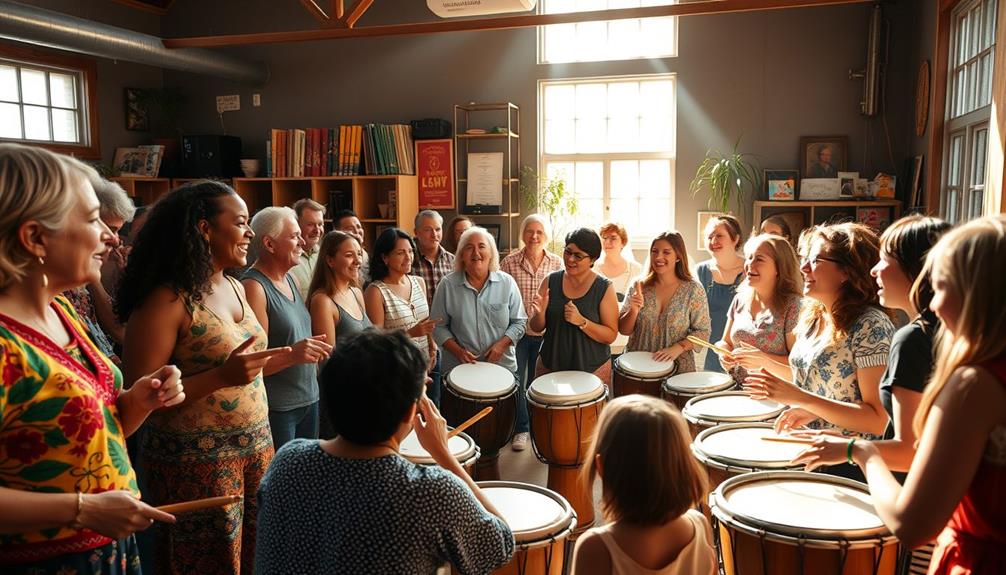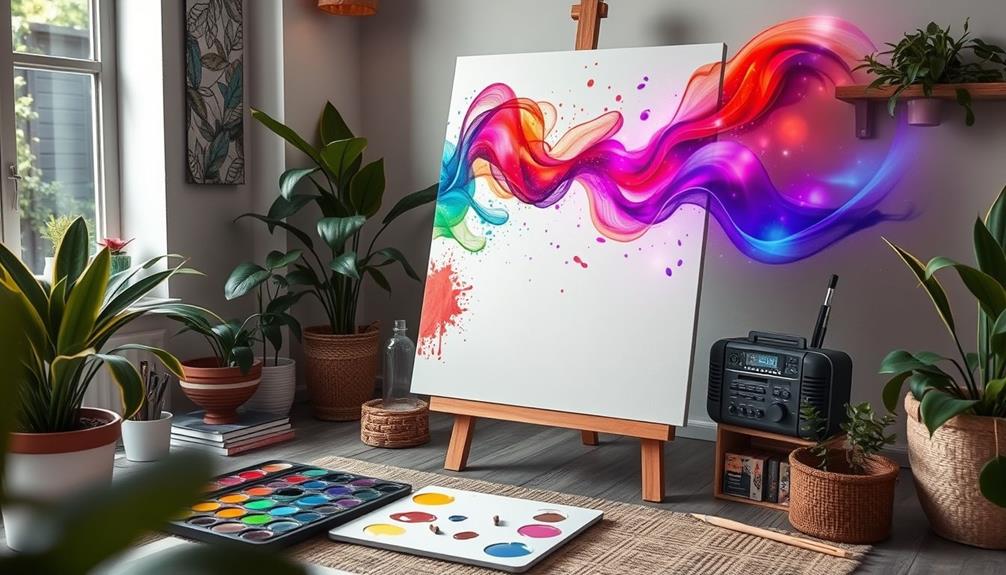You can easily incorporate music therapy into your daily life in a variety of ways. Start your day with uplifting tunes to boost your mood. Create tailored playlists that match your emotions or activities. Use calming music for relaxation, whether during meditation or unwinding after a busy day. Engage in group music activities with friends or family for connection. Incorporate music into your exercise routine for added motivation. Establish music rituals at home to strengthen family bonds. Emotional expression through music can bring clarity and relief. Discover even more creative ways to weave music into your life for enhanced well-being. The importance of music in recovery cannot be overstated. Whether recovering from physical injuries or mental health challenges, music can provide a powerful source of healing and comfort. Research has shown that music therapy can help reduce stress, alleviate pain, and improve mood in those undergoing recovery. By incorporating music into daily life, individuals can tap into its therapeutic benefits and support their journey towards healing and recovery.
Key Takeaways
- Start your day with uplifting music to enhance your mood and motivation as you wake up and prepare for the day ahead.
- Create personalized playlists that resonate with your emotions to manage feelings and improve focus during daily activities.
- Incorporate calming music into relaxation routines, such as during meditation or unwinding at home, to promote stress relief.
- Engage in community music activities, such as group singing or drumming circles, to foster social connections and emotional expression.
- Establish family music rituals, like shared playlists during meals or dance parties, to strengthen bonds and create joyful memories together.
Start Your Day With Music
Starting your day with music can truly set a positive tone for everything that follows. Instead of waking up to a jarring alarm, try using your favorite song to improve your experience. This smoother shift from sleep to wakefulness not only enhances your mood but also boosts your motivation levels right off the bat.
Incorporating elements of AI in music creation can provide you with personalized playlists that match your morning vibe.
Incorporating listening to music into your morning routine—whether you're showering or getting dressed—helps you enjoy those moments more without any extra effort. When you play uplifting or energizing playlists during breakfast, you'll notice a boost in productivity and a more enjoyable atmosphere as you prepare for the day ahead.
Don't forget about your commute! A few minutes of music can transform a mundane journey into a pleasurable experience, making it a great way to reduce stress before you tackle your daily tasks.
Create Tailored Playlists

Crafting tailored playlists can be a game-changer for your emotional well-being and daily productivity. By curating songs that truly resonate with your feelings, you can manage your mood effectively.
The ISO-principle suggests starting with music that matches your current emotions and gradually shifting to your desired state. Engaging with insights into human experience through music can profoundly enhance the therapeutic effects of your playlists.
Here are some ways to create tailored playlists:
- Personalize your playlists with favorite songs and meaningful lyrics that inspire you.
- Structure playlists for specific activities, like studying or exercising, to enhance focus and motivation.
- Use music breaks during your workday to refresh your mind and boost productivity.
- Regularly update your playlists to reflect changing emotions and activities, keeping the experience engaging.
Use Music for Relaxation

Creating a soothing playlist can be your go-to strategy for relaxation. By incorporating guided relaxation exercises with calming music, you'll find it easier to unwind after a hectic day.
Additionally, understanding the importance of music production software can enhance your ability to curate the perfect playlist for relaxation, allowing you to explore essential tools for creating enchanting music tracks.
Let's explore how these tools can help you achieve a deeper sense of calm.
Soothing Playlist Creation
A well-curated soothing playlist can be your secret weapon against daily stress and anxiety. By incorporating calming music into your routine, you enhance relaxation and promote emotional well-being.
For instance, listening to coffee's health benefits while enjoying your favorite tunes can elevate your mood. Here are some tips to create the perfect soothing playlist:
- Choose slow-tempo tracks: Aim for music that ranges from 60 to 80 beats per minute to help lower your heart rate.
- Select gentle melodies: Look for songs with minimal lyrics that can foster a peaceful atmosphere, making it easier to unwind after a long day.
- Include natural sounds: Incorporate tracks featuring water, birdsong, or nature sounds to create an immersive experience for relaxation.
- Practice consistently: Listen to your soothing playlist for just 10-15 minutes daily during your daily activities for a mental reset.
Guided Relaxation Exercises
Guided relaxation exercises offer a powerful way to unwind and de-stress, especially when paired with soothing music. Incorporating calming music into your sessions can greatly enhance the effectiveness of your practice. Research shows that combining music therapy with guided relaxation lowers heart rates and alleviates anxiety, making it easier for you to achieve a serene state.
To help you structure your sessions, consider utilizing a playlist of soft, ambient tracks. Here's a simple table to illustrate the benefits of music during guided relaxation:
| Element | Benefit |
|---|---|
| Calming Music | Reduces stress and anxiety |
| Structured Playlists | Supports immersive experiences |
| Breathing Techniques | Enhances focus during relaxation |
| Visualization Techniques | Promotes emotional well-being |
| Mindfulness Practices | Deepens connection to the present moment |
Engage in Group Music Activities

Joining community singing events or group drumming circles can transform your social life and enhance your well-being.
These activities not only foster connections with others but also promote emotional release and teamwork. Engaging in such group music activities can be as enjoyable as participating in crazy games that encourage laughter and bonding.
Community Singing Events
Engaging in community singing events offers a wonderful opportunity to connect with others while boosting your emotional well-being. When you participate in group music-making, you synchronize your physiological responses, enhancing your mood and fostering emotional bonding with fellow participants.
This shared experience can greatly reduce feelings of isolation, especially for seniors and individuals recovering from mental health issues. Additionally, group singing can improve auditory discrimination skills, which are essential for effective communication in social settings, making it an ideal complement to auditory processing improvement.
Here are some benefits of joining community singing events:
- Emotional Bonding: Strengthen connections with others through shared musical experiences.
- Reduce Isolation: Combat loneliness by engaging with a supportive group.
- Enhance Vocal Skills: Improve your singing abilities and self-expression in a fun, welcoming environment.
- Creative Outlet: Explore your creativity in a space that encourages self-discovery and enjoyment.
Most community centers and organizations host weekly or monthly singing sessions, making it easy for you to incorporate this uplifting activity into your routine.
Group Drumming Circles
Participating in group drumming circles creates a dynamic environment where you can connect with others while expressing yourself through rhythm. These circles foster social connection and teamwork, making it a fun way to engage with like-minded individuals.
As you drum together, you'll likely experience emotional release, helping to reduce stress and anxiety levels. Group drumming can also provide a sense of community that mirrors the importance of community building found in survivalist practices.
Research shows that group drumming can enhance cognitive functioning and improve motor skills, making it suitable for all ages and abilities. In a shared drumming experience, you'll notice how your heart rate and breathing synchronize with others, creating a powerful bond and a collective sense of relaxation.
This shared rhythm can deepen your emotional connection with fellow participants.
Group drumming also serves as an effective therapeutic intervention for various populations, from children with behavioral challenges to seniors facing cognitive decline. It promotes emotional regulation and boosts social interaction, making it a valuable addition to your daily routine.
Incorporate Music Into Exercise

Incorporating music into your exercise routine can transform your workouts into an invigorating experience. The right playlist not only enhances your motivation but also boosts your endurance. Studies show that listeners report higher enjoyment and performance levels, making it easier to push through fatigue.
Additionally, incorporating rhythmic activities such as yoga can help improve your overall workout experience, as it merges physical movement with yoga for back pain management and relaxation techniques.
To maximize the benefits of music during exercise, consider these tips:
- Choose upbeat songs: Aim for tracks with a tempo of 120-140 beats per minute, ideal for cardio.
- Create personalized playlists: Tailor your selections to match the intensity of your workout, keeping your mood elevated.
- Engage in rhythm-based activities: Activities like dance or drumming not only provide a workout but also enhance coordination and cognitive skills.
- Track your progress: Notice how incorporating music changes your workout duration and overall enjoyment.
Practice Mindfulness With Music

When you practice mindfulness with music, focused listening can transform your experience and help you connect with the present moment.
Integrating elements of aromatherapy techniques can further enhance your relaxation and emotional exploration.
Techniques like music and meditation or guided imagery can deepen your emotional exploration, providing a calming space to reflect.
Active Listening Techniques
Often, people overlook the power of music as a tool for mindfulness, but active listening can transform your everyday experience. By fully engaging with music, you can enhance your emotional awareness and promote relaxation.
Additionally, incorporating music into playtime can stimulate cognitive growth and emotional well-being in children, making it an excellent family activity promotes emotional well-being.
Here are some effective active listening techniques you can incorporate into your routine:
- Close your eyes: This helps you focus solely on the music and its elements.
- Take deep breaths: Center yourself and connect to your feelings as the music plays.
- Reflect on your emotions: Consider how the music makes you feel and what memories it evokes.
- Create a dedicated space: Find a distraction-free zone to immerse yourself in the experience.
Music and Meditation
Music can serve as a powerful ally in meditation, enhancing your mindfulness practice in profound ways. By incorporating music into your routine, you can create a serene atmosphere that promotes relaxation and focus. Music therapists often recommend specific melodies or nature sounds to deepen your meditation experience. Research shows that listening to calming music can lower your heart rate and blood pressure, contributing to emotional well-being.
Here are some effective ways to practice mindfulness with music:
| Type of Music | Benefits | Tips for Use |
|---|---|---|
| Calming Melodies | Enhances relaxation | Create a soothing playlist |
| Nature Sounds | Reduces stress | Use sounds from your environment |
| Rhythm-based Music | Grounds you in the present moment | Incorporate drumming sessions |
Guided Imagery With Music
Guided imagery with music (GIM) offers a transformative way to enhance your mindfulness practice. This therapeutic technique combines music listening with visualization to promote relaxation and emotional processing.
By engaging with carefully selected music, you can evoke imagery and memories that help explore your inner experiences in a safe environment.
To incorporate GIM into your daily routine, try these simple steps:
- Set aside time: Dedicate a few minutes each day for music listening.
- Choose calming music: Select tracks that resonate with you and evoke positive feelings.
- Practice visualization: While listening, visualize serene scenes or positive scenarios that encourage mindfulness.
- Reflect on emotions: After your session, take note of any feelings or insights that arise.
Research shows that GIM can greatly reduce anxiety and stress levels, fostering a sense of well-being.
Participants often report heightened awareness and improved emotional regulation.
Use Music for Emotional Expression

Finding ways to express your emotions can be a powerful journey, and incorporating music into your daily life is an effective method. Engaging in active music-making, like singing or songwriting, allows you to creatively express your feelings and experiences. This creative outlet promotes emotional release and catharsis, helping you process what you're going through.
Listening to music that resonates with your current emotions creates a safe space for reflection and understanding. You might find it helpful to use music-based worksheets that prompt you to select songs reflecting your feelings. This encourages personal exploration and insight into your emotional state.
The ISO-principle in music therapy suggests starting with music that matches your current emotions. Gradually shifting to uplifting tunes can aid in emotional regulation and enhance your mood.
Consider joining group therapy sessions, where shared musical experiences foster social connections and reduce feelings of isolation. Whether you're enjoying relaxing music on your own or participating in a group, music serves as a powerful tool for emotional expression, helping you navigate your feelings in a meaningful way.
Explore Musical Instruments

Engaging with musical instruments opens up a new dimension of emotional exploration and cognitive enhancement. By incorporating instruments into your daily life, you can tap into a powerful therapeutic outlet that promotes emotional well-being and cognitive development.
Whether you're strumming a guitar or playing a piano, the benefits are immense.
Consider these ways to explore musical instruments:
- Enhance cognitive skills: Learning to play activates multiple brain regions, boosting memory and attention.
- Social connections: Join group sessions to foster relationships and synchronize your physiological responses with others.
- Emotional expression: Use instruments to articulate feelings, helping reduce stress and align with music therapy principles.
- Create positive associations: Integrate music into family gatherings or personal downtime to improve your mood and quality of life.
Establish Music Rituals at Home

How can you create a nurturing environment that fosters emotional connection and well-being?
Establishing music rituals at home is a powerful way to enhance emotional well-being for you and your family. Start by creating a family playlist for mealtimes, bringing everyone together in a joyful atmosphere that reinforces positive associations with music.
You can also incorporate calming tracks into your evening routine, promoting relaxation and improving sleep quality.
Set aside regular music breaks where family members can engage in singing or playing instruments together. These moments not only enhance social interaction but also strengthen your family bonds.
Designate specific times for fun activities like dance parties or drumming circles, encouraging physical movement while boosting mood and emotional expression.
Connect Through Music With Family

Music can truly transform family dynamics, creating deeper connections and shared memories. By incorporating music into your daily life, you can enhance emotional bonds and foster a supportive environment.
Here are some engaging ways to connect through music with your family:
- Family Sing-Alongs: Gather everyone for fun sing-alongs. This activity releases endorphins, promoting happiness and reducing stress.
- Create a Family Playlist: Encourage each member to contribute their favorite songs. This fosters a sense of belonging and enhances communication.
- Rhythm-Based Activities: Participate in drumming circles or clapping games to improve coordination and teamwork while having fun together.
- Incorporate Music into Routines: Play calming tunes during meals or energetic tracks during playtime to create positive associations and enhance the overall atmosphere at home.
Frequently Asked Questions
How to Incorporate Music Into Everyday Life?
To incorporate music into your everyday life, use it as an alarm, curate energizing playlists for commutes, play upbeat tunes while cleaning, take short music breaks at work, and join local music groups for social connection.
How Can Music Help Us in Our Everyday Life?
Music helps you enhance your mood, reduce stress, and boost productivity. It creates enjoyable experiences during commutes, promotes relaxation before bed, and strengthens social connections through participation, enriching your everyday life in countless ways.
How Is Music Therapy Being Used Today?
Music therapy's being used today to enhance emotional well-being, reduce anxiety, and promote healing. You can experience its benefits through active music-making or receptive listening, tailored to your unique therapeutic needs and goals.
What Does a Music Therapist Do on a Daily Basis?
A music therapist designs personalized treatment plans, conducts sessions, engages clients in active music-making, and assesses progress. You'll collaborate with healthcare professionals, document outcomes, and adapt strategies to guarantee effective therapy for each individual.
Conclusion
By weaving music therapy into your daily routine, you're painting your life with vibrant melodies and soothing harmonies. Each note becomes a brushstroke, creating a masterpiece of emotional well-being and connection. Whether you're waking up to your favorite tunes or strumming an instrument, let music be your guiding star. Embrace its power to uplift, heal, and unite, and watch as your days transform into a symphony of joy and resilience. Start your musical journey today!










